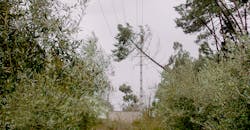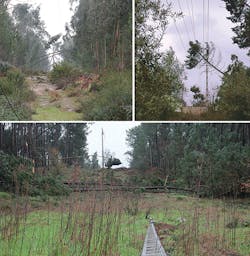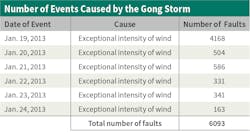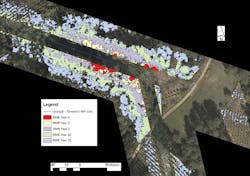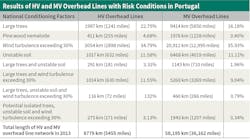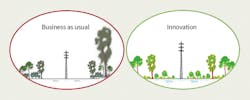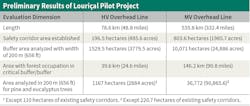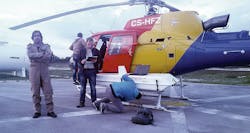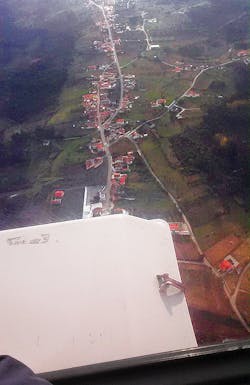Utility Tames Extreme Weather
A large proportion of Portugal’s service territory is populated by forests that extend to 3.2 million hectares (7.9 million acres), some 36% of the geographical area. The Portuguese distribution system operator (DSO), Energias de Portugal Distribuição (EDPD), is responsible for operation of the high-voltage (HV) and medium-voltage (MV) networks. These networks include 23,200 km (14,416 miles) of overhead lines erected in forest regions and 8300 km (5157 miles) of overhead lines routed through forests and areas designated for nature conservation. The overhead lines are exposed to hazards such as wild fires and damage caused by falling trees, especially during extreme weather events.
Portuguese legislation requires the DSO to establish and manage overhead line safety corridors, including some corridors for forest fuel management. For HV and MV overhead lines, the regulatory safety corridors are 12.5 m (41 ft) and 7.5 m (24.6 ft) wide, respectively. Forest fuel management minimizes the surface area that can be devastated by large fires by enabling and facilitating direct intervention of firefighting equipment. Nevertheless, they are subject to the same regulatory width of safety corridors.
Prior Maintenance
The maintenance of overhead lines is conducted every four years by traditional light detection and ranging (LiDAR) flights flying over the overhead lines to monitor the safety corridors and status of conductors. However, these standard practices have proved to be insufficient during extreme weather events, as trees with heights of 40 m (131 ft) located outside the safety corridor may fall and damage overhead lines.
Recently, Portugal has experienced several extreme weather events that have had an adverse impact on the reliability of the distribution network. For example, since 2009, four major storms have resulted in a significant impact on the fault interruption (length of supply interruption) statistics on the distribution network. For instance, a single storm in 2013, named Gong, caused an equivalent interruption time of 30 minutes, according to the system average interruption duration index (SAIDI), or TIEPI in Spanish, which focuses on the average interruption time weighted by the rated power. This represents 50% of the total annual TIEPI calculated per the parameters set by the regulator.
Research Project
EDPD has developed a research project aimed at increasing the reliability of overhead lines in forests while managing safety corridors with solutions that yield positive environmental impacts. The concept of a risk-management buffer (RMB) was developed by EDPD in cooperation with FloraSul, an environmental nongovernmental organization that aims to conserve forest grounds throughout the entire country.
An extreme weather event might cause trees to fall or branches to make contact with lines, resulting in damage to the overhead line conductors. These events are more likely to occur in areas prone to strong wind turbulence and with tall trees, particularly isolated pine or eucalyptus trees, pine trees weakened by a parasite (nematode) or isolated trees growing in unstable soils.
The RMB consists of extending the risk analysis to areas outside the existing safety corridors for HV and MV overhead lines, with the purpose of increasing the resilience of the overhead line circuits subject to extreme meteorological events.
Land-Use Cartography
The research project required the compilation of land-use cartography (LUC) — using helicopter-mounted LiDAR and a high-definition (HD) camera with red, green, blue/near infrared (RGB/NIR) to record large areas — to identify large trees within falling distance of the overhead lines. The LUC solution also records the forest species in close proximity to the overhead lines as well as pine trees potentially affected by pests and diseases.
An innovative advanced methodology of LiDAR and HD image data processing was developed for this project, with an average cost of 450 euros/km (US$791/mile). Critical areas are identified by the LiDAR and HD camera to record the forest features in terms of location and the type and size of trees that may present a potential risk.
Research Results
The results showed a significant percentage of HV and MV overhead lines are exposed to these conditioning factors, which justify the strategies and precautionary measure assessments to prevent incidents that arise from contact with overhead line conductors by falling trees in the existing safety corridors.
The impact of meteorological events is unevenly distributed, with a small number of highly energetic extreme weather events occurring less than once a year. These occur in certain parts of the country, for example, the coastal area north of Lisbon. Data analysis showed, even though extreme weather events are associated with strong winds and precipitation, the wind factor proves to be the most significant variable that causes the occurrence of overhead line incidents. Lightning discharges were not identified as a major risk to the impact on network reliability as quantified by TIEPI, or the average interruption time weighted by the installed capacity.
The results showed a greater chance of extreme events impacting TIEPI in the west region, between Sintra and Pombal, and extending inland north of Lisbon.
Alternative Solutions
EDPD continues to consider alternative solutions to improve the reliability of its HV and MV overhead line networks, being mindful of the solutions adopted by distribution utilities faced with similar problems. The alternative solutions are as follows:
- Installing underground cables as an alternative to overhead lines
- Using insulated overhead line conductors
- Using aerial-bundled conductors on overhead lines
- Strapping the trees.
Further solutions specified within EDPD’s operating contingency action plan include the use of temporary cables and modular temporary poles designed for a range of applications. These alternative solutions are implemented if the RMB methodology does not have a positive cost-benefit analysis.
Pilot Project
Louriçal is one of the regions vulnerable to extreme weather events, combining high exposure with the existence of extensive forest cover and unstable soil conditions. In 2013, Louriçal suffered a large storm (Gong) that damaged the overhead line networks. The Portuguese DSO opted to use this area as a pilot for the RMB concept.
Louriçal covers three municipalities in Portugal with a total area of 1269 sq km (490 sq miles) and a population of 136,587, about 1.3% of Portugal’s total population. The area represents 1.4% of the area of continental Portugal and includes almost 2% of the total area of Portugal’s forest cover.
The pilot project involves interactions with various stakeholders, including local authorities, landowners and environmental associations, to maximize the opportunities associated with safety corridor management. This intervention area includes 614 km (382 miles) of HV and MV overhead lines. The implementation of the Louriçal pilot project has provided some preliminary results for the areas surrounding the routes of the overhead lines that require management.
The preliminary results found the trees located outside the safety corridors far exceed the recommended heights. In those areas, the RMB must be wider, being defined by the location and size of trees that might fall on the overhead line conductors. The RMB is identified through the use of helicopter-mounted LiDAR surveys and a HD camera, and the advanced methodology of data analysis.
Profitability Measures
RMB intervention is only performed following an economic and financial evaluation. The expected economic value of a project is estimated based on operating cashflows, which result from the provisional account of exploration and represent the difference between benefits and investment costs. Among other possible expected profitability measures, the benefit-cost ratio can be used for investment decisions.
One crucial part of this project is the identification of trees presenting a hazard to overhead lines and negotiation with the owners on whose land the overhead lines are constructed. The owner’s identification is obtained through various sources, including local authorities, landowners and environmental associations. The negotiations are based on tabulated values of compensation for trees in the current safety corridors. It is essential to notice the implementation of the RMB concept involves a business transaction that must be beneficial to all parties, the DSO and the landowner. For the implementation of RMB, the best solution is to eliminate risk during the life cycle of the overhead line by reforestation.
Invasive Species
The invasive tree species, Acacia, was identified as being present in most of the safety corridors. Because of its fast growth, the existence of this species increases maintenance costs by up to four times the average cost. Furthermore, the species is considered a problem by environmental authorities. The ideal solution is to eliminate this species in the RMB, promoting the planting of small tree species that do not grow to a height that would interfere with the overhead line conductors.
Although this is the ideal solution, it may not be the most cost effective; therefore, in the implementation of the RMB, two scenarios are possible, which are selected depending on the outcome of the cost-benefit analysis:
1. Reforestation of the intervention areas with slow-growing species, with the expectation they cannot grow to a size or height likely to be able to interfere or fall on overhead line conductors
2. The reconversion of land use on the intervention areas.
In both scenarios, a register of the quantity of carbon associated with the trees that are removed is retained to compensate for the loss by planting indigenous tree species.
The evaluation and monitoring of the RMB for the areas surrounding safety corridors will anticipate prevention and mitigation of the potential risk to the overhead lines. This strategy is incorporated throughout the life cycle of the infrastructure. The RMB will have a dynamic and variable width depending on the heights of the species.
The implementation of this project in Louriçal has some benefits, such as improving the reliability and quality of supply. This has been the result of providing sustainable management of the interaction of HV and MV overhead line networks with the surrounding areas, while promoting biodiversity and mitigating carbon-dioxide emissions through reforestation.
Pilot Surveys
To verify the benefits of RMB that are reliant on the use of a LiDAR flight and HD camera, EDPD selected a 20-km (12.4-mile) section of the HV and MV overhead line network and invited four service providers to participate. The LiDAR flight and HD camera was performed by the experienced EDP Group Consortium member EDP Labelec, which monitors overhead lines for EDPD. The three remaining service providers employed RGB and NIR technologies to produce the HD aerial images to monitor the overhead lines.
EDPD’s evaluation of the work of the four providers concluded only the LiDAR and HD camera (RGB/NIR) was adequate for achieving the data needed to identify the risk and manage the forest areas.
Net Savings
The methodology associated with the creation of the RMB concept was developed with the involvement of the environmental nongovernmental organization FloraSul and using LiDAR and HD camera (RGB/NIR) technology with advanced data analysis, at a cost of 450 euros/km (US$791/mile). The implementation of risk-mitigation measures is done in areas where a positive cost-benefit analysis is achieved and must involve stakeholders and local landowners.
RMB is expected to increase the resilience of overhead lines subject to extreme meteorological events, while achieving economic benefits and also providing environmental benefits. The expenditure on the pilot project will be 2 million euros (US$2.19 million) and the benefits are estimated to be 3 million euros (US$3.28 million), resulting in a net saving of 1 million euros (US$1.09 million). ♦
Maria Inês Verdelho has a MSEE degree, specializing in energy, control and automation systems. Currently, Verdelho is working in the network planning department at Energias de Portugal. She is an author and co-author of conference papers on the analysis of risk methodologies and innovative solutions on safety corridor design for overhead lines.
Ricardo Prata has a MSEE degree and is completing a Ph.D. in engineering and public policy. He is the assistant director of the planning department at Energias de Portugal Distribuição. His intervention areas include the development of technical risk-assessment methodologies, assessment of long-term investment needs associated with infrastructure sustained renewal and performance.
Silvestre Pereira is an electrotechnical engineer, specializing in the design and distribution network in various geographies. He is a group employee of Energias de Portugal. For the past 10 years, Pereira has been coordinating studies and the environmental component of the framework projects in the areas of forestry and landscape preservation.
Miguel Vieira is an expert on environment, development, geography and information systems for the management of Energias de Portugal. He was a member of the experts group of the International Union for Nature Conservation and of the European Environmental Bureau. He is president of the environmental non-governmental organization FloraSul and has authored many studies and projects.
About the Author
Maria Inês Verdelho
Maria Inês Verdelho has a MSEE degree, specializing in energy, control and automation systems. Currently, Verdelho is working in the network planning department at Energias de Portugal. She is an author and co-author of conference papers on the analysis of risk methodologies and innovative solutions on safety corridor design for overhead lines.
Ricardo Prata
Assistant Director of Planning
Ricardo Prata has a MSEE degree and is completing a Ph.D. in engineering and public policy. He is the assistant director of the planning department at Energias de Portugal Distribuição. His intervention areas include the development of technical risk-assessment methodologies, assessment of long-term investment needs associated with infrastructure sustained renewal and performance.
Silvestre Pereira
Electrotechnical Engineer
Silvestre Pereira is an electrotechnical engineer, specializing in the design and distribution network in various geographies. He is a group employee of Energias de Portugal. For the past 10 years, Pereira has been coordinating studies and the environmental component of the framework projects in the areas of forestry and landscape preservation.
Miguel Vieira
President
Miguel Vieira is an expert on environment, development, geography and information systems for the management of Energias de Portugal. He was a member of the experts group of the International Union for Nature Conservation and of the European Environmental Bureau. He is president of the environmental non-governmental organization FloraSul and has authored many studies and projects.
